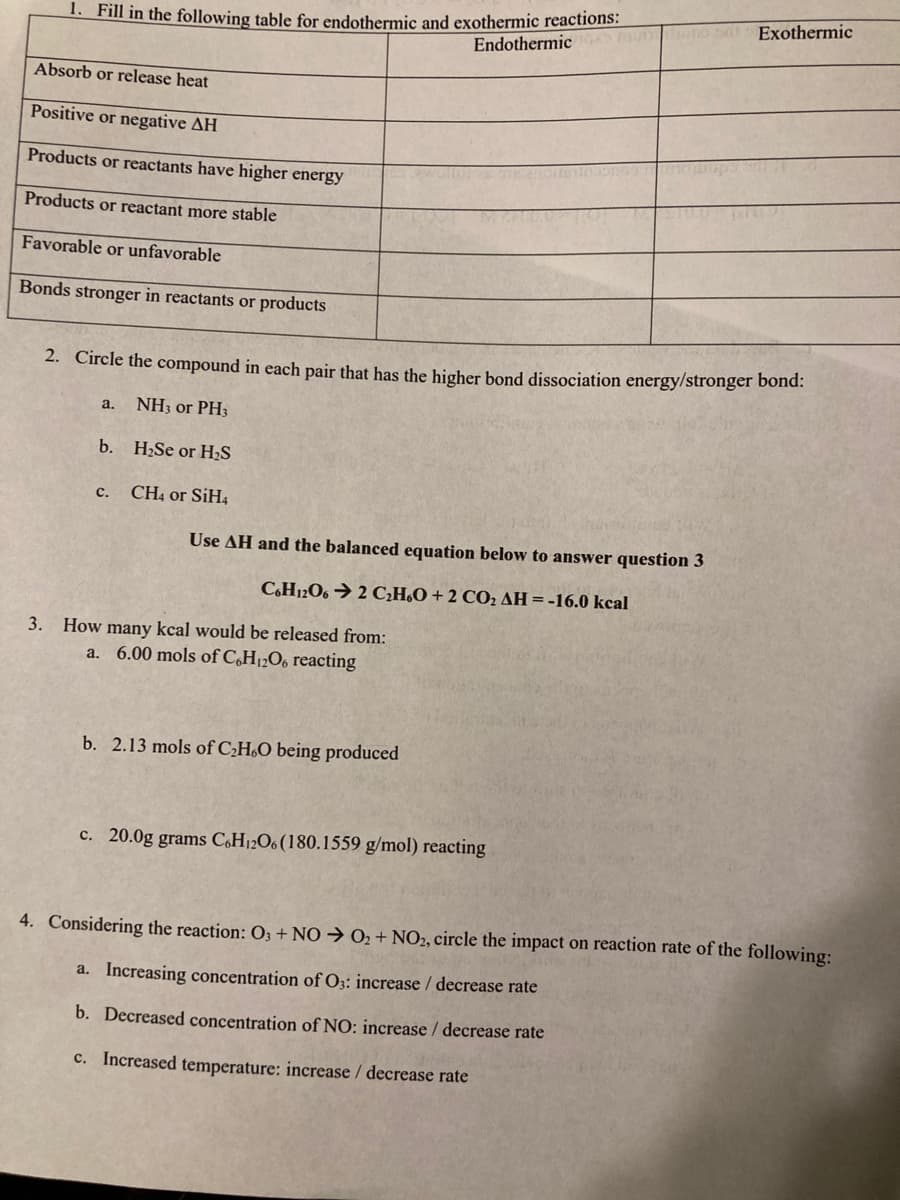Organic Chemistry: A Guided Inquiry
2nd Edition
ISBN:9780618974122
Author:Andrei Straumanis
Publisher:Andrei Straumanis
Chapter17: Conjugation And Molecular Orbital (mo) Theory
Section: Chapter Questions
Problem 5E
Related questions
Question

Transcribed Image Text:Exothermic
1. Fill in the following table for endothermic and exothermic reactions:
Endothermic n no so
Absorb or release heat
Positive or negative AH
Products or reactants have higher energy
Products or reactant more stable
Favorable or unfavorable
Bonds stronger in reactants or products
2. Circle the compound in each pair that has the higher bond dissociation energy/stronger bond:
a.
NH3 or PH3
b. H2Se or H2S
с.
CH4 or SIH4
Use AH and the balanced equation below to answer question 3
C,H12O6→ 2 C;H,O + 2 CO2 AH = -16.0 kcal
3. How many kcal would be released from:
a. 6.00 mols of C,H12O6 reacting
b. 2.13 mols of C¿HO being produced
c. 20.0g grams C,H12O6 (180.1559 g/mol) reacting
4. Considering the reaction: O3 + NO → 02 + NO2, circle the impact on reaction rate of the following:
a. Increasing concentration of O3: increase / decrease rate
b. Decreased concentration of NO: increase / decrease rate
c. Increased temperature: increase / decrease rate
Expert Solution
This question has been solved!
Explore an expertly crafted, step-by-step solution for a thorough understanding of key concepts.
Step by step
Solved in 3 steps with 1 images

Knowledge Booster
Learn more about
Need a deep-dive on the concept behind this application? Look no further. Learn more about this topic, chemistry and related others by exploring similar questions and additional content below.Recommended textbooks for you

Organic Chemistry: A Guided Inquiry
Chemistry
ISBN:
9780618974122
Author:
Andrei Straumanis
Publisher:
Cengage Learning

Chemistry: An Atoms First Approach
Chemistry
ISBN:
9781305079243
Author:
Steven S. Zumdahl, Susan A. Zumdahl
Publisher:
Cengage Learning


Organic Chemistry: A Guided Inquiry
Chemistry
ISBN:
9780618974122
Author:
Andrei Straumanis
Publisher:
Cengage Learning

Chemistry: An Atoms First Approach
Chemistry
ISBN:
9781305079243
Author:
Steven S. Zumdahl, Susan A. Zumdahl
Publisher:
Cengage Learning


Chemistry
Chemistry
ISBN:
9781305957404
Author:
Steven S. Zumdahl, Susan A. Zumdahl, Donald J. DeCoste
Publisher:
Cengage Learning

Living By Chemistry: First Edition Textbook
Chemistry
ISBN:
9781559539418
Author:
Angelica Stacy
Publisher:
MAC HIGHER
